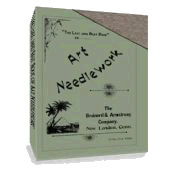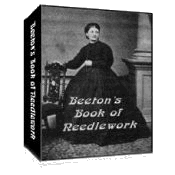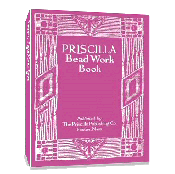French Laid Embroidery
or
WHITE WORK
THE CORRECT WAY TO DO INITIALING
If one were asked to mention the kind of embroidery in most general use, we may say universal use, the answer would undoubtedly be “French laid work.” Professional workers and amateurs in all countries and from time immemorial have seemed to thoroughly appreciate the  beauty, the durability, and perfect practicability of the firmly laid Satin stitch in white embroidery. Its very nature makes it generally serviceable and appropriate to all applications of household decoration, the table and all dining-room linens, bed decoration and all toilet-table linens, clothing, both for marking and decorating it, especially infants' clothes, pillows, caps, etc.
beauty, the durability, and perfect practicability of the firmly laid Satin stitch in white embroidery. Its very nature makes it generally serviceable and appropriate to all applications of household decoration, the table and all dining-room linens, bed decoration and all toilet-table linens, clothing, both for marking and decorating it, especially infants' clothes, pillows, caps, etc.
Many people undertake French Laid embroidery without a notion that there is a proper way to do it or that upon correctness depends success. If there is any sort of embroidery which really should be learned as sewing should, for its practical value, it is this "French laid work." Household linens ought to be marked in this way. One may use the most simple letters for this marking or they can be ornate and decorative and so answer more than one purpose.
In the first place French Laid embroidery should be raised. The stitches are
 |
close and firm, so that if all the work is done with an even tension very high raising can be done even on fine fabrics. One half the success depends on the underfilling, which is indeed one half the work. The first step of this preparatory work should always be done in the direction of the length of the bar, or line, or form, whatever it may be. The stitches should be long and the final covering stitches should be at right angles to this work. How many times a form shall be covered depends entirely upon how high one wishes to raise it, but it is necessary to cover it at least once in the direction of the length (see Fig. 1) and then to bind these stitches somewhat so they will be firm and not looping. See Fig. 2. One might contend that the overwork would bind them sufficiently, but this is not the case. The overwork will never be firm if the underwork is not made hard and firm first before a single overstitch is laid. The first row of binding-in stitches should be placed at a decided slant over the long straight stitches of the first layer of the filling. See Fig. 2. This will be sufficient  for slight raising, but, for higher, another row of binding stitches should be laid at an opposite angle from the first. See Fig. 3. When the letter or device is made up of curves, as in Fig. 3, the first row of under stitches must be something of the nature of overlap work in order that the line shall keep the center of the form, instead of long straight stitches as on forms made up of straight lines.
for slight raising, but, for higher, another row of binding stitches should be laid at an opposite angle from the first. See Fig. 3. When the letter or device is made up of curves, as in Fig. 3, the first row of under stitches must be something of the nature of overlap work in order that the line shall keep the center of the form, instead of long straight stitches as on forms made up of straight lines.
This is all the underfilling one should place for ordinary work, and if an equal tension has been maintained and the work as carefully done as though it were to show, instead of being preparatory, the raised letter or ornament will be hard and indeed very presentable in itself. For further raising place more long stitches in the same direction as the first row, and bind these again. See Fig. 4. The wider the form the more raising one may venture upon within a certain limit, but a difficulty arises at once in regard to keeping within the outline of any form. It will be noticed in Figs. 1, 2, 3, and 4 that the underfilling in no case extends to the outline on either side. The more layers of filling stitches one intends to have the farther from the outline must the first of these be kept. The outline itself is the guide to the covering layer. The reason for this care is obvious. If the underfilling approaches too near to covering the entire width of the form the result will be an increase of the original width. Often the proportions are quite spoiled in this way and a very awkward letter or device is the result. It is difficult to keep the outline perfectly in raised white work, but perfect outlines and clear cut edges are the chief beauties of this kind of embroidery.
one intends to have the farther from the outline must the first of these be kept. The outline itself is the guide to the covering layer. The reason for this care is obvious. If the underfilling approaches too near to covering the entire width of the form the result will be an increase of the original width. Often the proportions are quite spoiled in this way and a very awkward letter or device is the result. It is difficult to keep the outline perfectly in raised white work, but perfect outlines and clear cut edges are the chief beauties of this kind of embroidery.
A very simple rule embraces the method of the overwork of French Laid embroidery, but it means a great deal and must be accurately followed. The stitches must be laid at right angles to the direction of the forms, that is, straight across by the shortest distance. As the form changes its direction the overstitches must change theirs, gradually if the deviation is slight, abruptly if they are following a curve which suddenly reverses its direction. In order to accomplish these turns it is necessary to crowd the stitches on the inside of the curve or angle and spread them a little on the outside. This must be done without being apparent and, in order that it can be, the turn or curve must be calculated on from the start. One must see ahead, slant each stitch slightly so that none will take a decided position in contrast to the others, but all seem part of the whole unbroken series. See Fig. 5. All the stitches in this except those exactly in the center of the curve crowd slightly on the
changes its direction the overstitches must change theirs, gradually if the deviation is slight, abruptly if they are following a curve which suddenly reverses its direction. In order to accomplish these turns it is necessary to crowd the stitches on the inside of the curve or angle and spread them a little on the outside. This must be done without being apparent and, in order that it can be, the turn or curve must be calculated on from the start. One must see ahead, slant each stitch slightly so that none will take a decided position in contrast to the others, but all seem part of the whole unbroken series. See Fig. 5. All the stitches in this except those exactly in the center of the curve crowd slightly on the  inside and spread the least trifle on the outside. All the stitches then are not at right angles with the upright position of the letter but at right angles with the direction of the lines and curves which form it. This is an unerring rule and perfectly easy to apply to all French laid work, whether letters, scrolls, leaves, or ornaments of any sort. It keeps the embroidery absolutely conventional, as it should be, and characterizes it as an especial style.
inside and spread the least trifle on the outside. All the stitches then are not at right angles with the upright position of the letter but at right angles with the direction of the lines and curves which form it. This is an unerring rule and perfectly easy to apply to all French laid work, whether letters, scrolls, leaves, or ornaments of any sort. It keeps the embroidery absolutely conventional, as it should be, and characterizes it as an especial style.
Slender lines in French Laid embroidery, as shown in Fig. 6, are embroidered over one thread, and this is placed from end to end in one stitch and drawn to the curve as the covering proceeds. It is indeed easier to keep the stitches of this narrow  line even than wider ones; it looks difficult only because it is fine. The long under stitch must not be too tight nor yet too loose. The underfilling of the stems should also be a single line but laid in Split stitch, that is, the needle should cut through the stitch already laid, which should be long but not long enough to leave the outline. Each succeeding stitch should cut through the preceding, as in the edge line of Fig. 7.
line even than wider ones; it looks difficult only because it is fine. The long under stitch must not be too tight nor yet too loose. The underfilling of the stems should also be a single line but laid in Split stitch, that is, the needle should cut through the stitch already laid, which should be long but not long enough to leave the outline. Each succeeding stitch should cut through the preceding, as in the edge line of Fig. 7.
The worker should not be discouraged if the first attempts at French Laid embroidery are failures, because this work, seemingly so simple, requires the greatest accuracy, and accuracy involves more of patient practice to obtain than any other quality. It is, however, obtainable by anyone who will work for it and this is more than can be said for many of the qualities necessary to success in embroidery.
Return to top of French Laid Embroidery page.



 433 pages!
433 pages!

